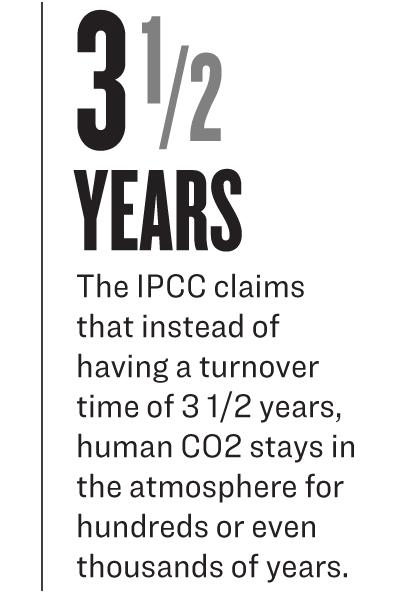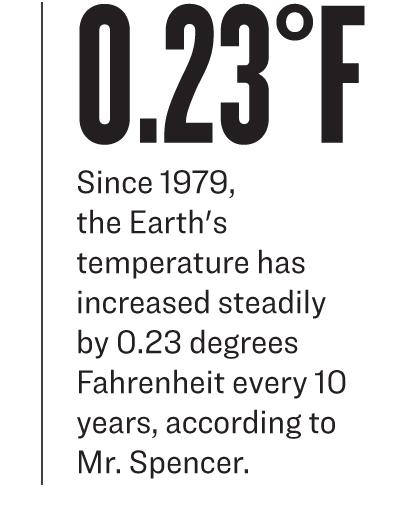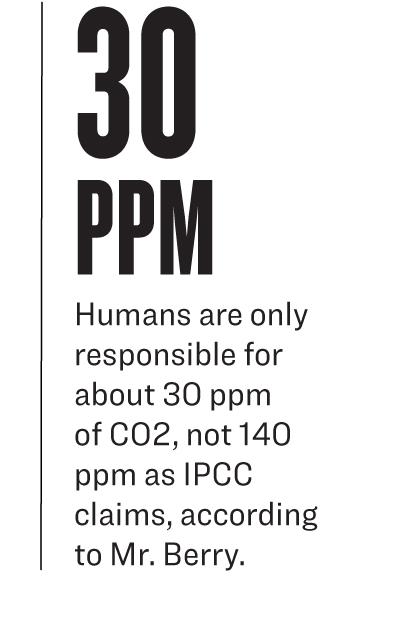More than 1,600 scientists and informed professionals signed the Global Climate Intelligence Group’s “World Climate Declaration.”
In the 1980s, we were facing a new Ice Age. When no Ice Age killed Earth’s population, we were warned of the exact opposite: “By the end of the 199s, Global Warming will burn Earth into nothing more than cinders.”
That’s what 1,808 scientists and informed professionals stated when they signed the Global Climate Intelligence Group’s “World Climate Declaration.”
“Climate science should be less political, while climate policies should be more scientific,” the declaration begins. “Scientists should openly address uncertainties and exaggerations in their predictions of global warming, while politicians should dispassionately count the real costs as well as the imagined benefits of their policy measures.”
The declaration’s signatories include Nobel laureates, theoretical physicists, meteorologists, professors, and environmental scientists worldwide. And when a select few were asked why they signed the declaration stating that the “climate emergency” is a farce, they all stated a variation of “because it’s true.”
“There is plenty of evidence that average temperatures were higher during the so-called Medieval Warm Period (centered around the year 1000), the Roman Warm Period (when grapes and citrus fruits were grown in now much colder Britain), and in the early Holocene (after the last regular Ice Age ended).”
The climate emergency is “fiction,” he said unequivocally.

The “Climate Emergency”
Human activities and the resulting greenhouse gases are the cause of global warming, according to the Intergovernmental Panel on Climate Change (IPCC). Specifically, the IPCC says that in 1750, atmospheric carbon dioxide (CO2) concentrations were 280 parts per million (ppm), and today, the atmospheric CO2 concentrations are 420 ppm, which affects temperature.
Edwin Berry, a theoretical physicist and certified consulting meteorologist, said that one of the IPCC’s central theories is that natural CO2 has stayed constant at 280 ppm since 1750 and that human CO2 is responsible for the 140 ppm increase.
This IPCC theory makes human CO2 responsible for 33 percent of today’s total CO2 level, he told members of the Media.
Consequently, to decrease temperatures, the IPCC says, we must reduce human-caused CO2 — thus, the current push by lawmakers and climate activists to forcibly transition the world’s transportation to electric vehicles, get rid of fossil fuels, and generally reduce all activities that contribute to human-caused CO2.
That entire premise, according to Mr. Berry, is problematic.
“The public perception of carbon dioxide is that it goes into the atmosphere and stays there,” Mr. Berry said. “They think it just accumulates. But it doesn’t.”
 He explained that when you look at the flow of carbon dioxide — “flow” meaning the carbon moving from one carbon reservoir to another, i.e., through photosynthesis, the eating of plants, and back out through respiration — a 140 ppm constant level requires a continual inflow of 40 ppm per year of carbon dioxide, because, according to the IPCC, carbon dioxide has a turnover time of 3.5 years (meaning carbon dioxide molecules stay in the atmosphere for about 3 1/2 years).
He explained that when you look at the flow of carbon dioxide — “flow” meaning the carbon moving from one carbon reservoir to another, i.e., through photosynthesis, the eating of plants, and back out through respiration — a 140 ppm constant level requires a continual inflow of 40 ppm per year of carbon dioxide, because, according to the IPCC, carbon dioxide has a turnover time of 3.5 years (meaning carbon dioxide molecules stay in the atmosphere for about 3 1/2 years).“A level of 280 ppm is twice that — 80 ppm of inflow. Now, we’re saying that the inflow of human carbon dioxide is one-third of the total. Even IPCC data says, ‘No, human carbon dioxide inflow is about 5 percent to 7 percent of the total carbon dioxide inflow into the atmosphere,'” he said.
So, to make up for the lack of necessary human-caused carbon dioxide flowing into the atmosphere, the IPCC claims that instead of having a turnover time of 3.5 years, human CO2 stays in the atmosphere for hundreds or even thousands of years.
“[The IPCC is] saying that something is different about human carbon dioxide and that it can’t flow as fast out of the atmosphere as natural carbon dioxide,” Mr. Berry said. “Well, IPCC scientists—when they’ve gone through, what, billions of dollars?—should have asked a simple question: ‘Is a human carbon dioxide molecule exactly identical to a natural carbon dioxide molecule?’ And the answer is yes. Of course!
“Well, if human and natural CO2 molecules are identical, their outflow times must be identical. So, the whole idea where they say it’s in there for hundreds, or thousands, of years, is wrong.”
Mr. Berry said that means nature—not humans—caused the increase in CO2. Consequently, attempts to decrease human CO2 are pointless.
“The belief that human CO2 drives the CO2 increase may be the biggest public delusion and most costly fraud in history,” Mr. Berry said.
He pointed out that in science, the scientific method says that you can’t prove that a theory is 100 percent true—only that the data supports it—but you can prove that it’s false. Providing an example, Mr. Berry said that Sir Isaac Newton’s gravity law was the preeminent theory for a long time. Still, Albert Einstein made a correction that disproved Newton’s theory.
Mr. Berry took his research a step further and calculated the human carbon cycle using the IPCC’s own carbon cycle data.
“The prediction from the same model doesn’t give humans producing 140 ppm. It comes out closer to 30 ppm. Which essentially means the IPCC is wrong,” he said.
He said that using the IPCC’s data, nature is responsible for about 390 ppm of CO2, and humans are only responsible for about 30 ppm—not 140 ppm.
“Now, someone could ask, ‘Well, is the IPCC data correct?’ My answer is, ‘I don’t know.’ But I don’t have to know because IPCC has used this very data to deceive the world. I want to show that their logic is incorrect using their data,” he said.
“The IPCC was not set up as a scientific organization.”
Mr. Berry said that the IPCC doesn’t engage in skepticism of its theories and, therefore, the scientific method that governs all science.
“They were set up as a political organization to specifically convince the public that carbon dioxide was causing problems,” he said.
When asked why there’s a push to declare a “climate emergency,” Mr. Berry said it’s all about money and control.
“That’s the only real reason for it. There’s no climate emergency,” he said.
Politics and Climate Models
Like Mr. Berry, Mr. Alexander says that science has become more political than scientific.
“It’s simply not true that the Earth’s climate is threatened. That claim is far more political than scientific,” he said.
“Science is based on observational evidence, together with logic, to make sense of the evidence. Very little, if any, evidence exists that human emissions of CO2 cause rising temperatures. There is a correlation between the two, but the correlation isn’t particularly strong: The Earth cooled, for example, from about 1940 to 1970, while the atmospheric CO2 level continued to go up. Computer climate models are all that connects global warming to CO2.”
When asked why CO2 was singled out as the cause of the climate emergency, Mr. Alexander said it goes back to James Hansen, an astrophysicist and the head of NASA’s Goddard Institute for Space Studies from 1981 to 2013 and an ardent environmentalist.
“Hansen developed one of the first computer climate models and began to make highly exaggerated predictions of future warming, none of which have come true,” Mr. Alexander said. “This included testimony he gave at a 1986 Senate hearing, testimony considered to have sparked the subsequent anthropogenic global warming narrative.”
Despite his predictions failing to come to fruition, Mr. Hansen’s efforts contributed to the founding of the IPCC, Mr. Alexander said.
“Although ostensibly the IPCC is a scientific body, the findings of its scientists are frequently distorted and hyped by the government and NGO bureaucrats who dominate the organization,” he said. “The bureaucrats have played a major role in exaggerating the scientific conclusions of successive IPCC reports and escalating the rhetoric of its official pronouncements. Hence, the U.N. secretary-general’s recent proclamations about a ‘boiling’ earth.”
Mr. Alexander said an honest answer to what’s causing Earth’s warming is, “We just don’t know right now,” but that doesn’t mean scientists are short of ideas.
“The chances of CO2 being the number one culprit are very slim. CO2 undoubtedly contributes, but there are several natural cycles that most likely do, too,” he said. “These include solar variability and ocean cycles, both ignored in climate models — because we don’t know how to incorporate them — or represented poorly. While climate activists will tell you otherwise, climate science is still in its infancy, and there is a great deal we don’t yet understand about our climate.”
He said one example is a recent research paper that estimated that changes in the sun’s output could explain 70 to 80 percent of global warming. Research such as that doesn’t gain much traction because the IPCC is committed to the idea that human CO2 is the cause of global warming.
As further criticism, Mr. Alexander said John Christy, a climatologist and professor of atmospheric science at the University of Alabama in Huntsville and the director of the Earth System Science Center, has clearly demonstrated that climate models exaggerate short-term future warming by two to three times.
 “All these large-scale and small-scale approximations are incorporated in the model in the form of adjustable numerical parameters — often termed ‘fudge factors’ by scientists and engineers. The famous mathematician John von Neumann once said, ‘With four [adjustable] parameters, I can fit an elephant, and with five, I can make him wiggle his trunk.'”
“All these large-scale and small-scale approximations are incorporated in the model in the form of adjustable numerical parameters — often termed ‘fudge factors’ by scientists and engineers. The famous mathematician John von Neumann once said, ‘With four [adjustable] parameters, I can fit an elephant, and with five, I can make him wiggle his trunk.'”Mr. Neumann’s saying means that people shouldn’t be impressed when a complex model fits a data set because, with enough parameters, you can fit any data set.
Mr. Benaroya echoed Mr. Alexander’s criticism but took it further regarding climate modeling.
“All climate model predictions have been wrong,” Mr. Benaroya stated. “It is important to understand that a computational model of the atmosphere is inherently inaccurate. This is not the fault of the researchers.
“It is due to the enormous complexity of the climate — chemistry; fluid mechanics; heat transfer; effects of solar radiation; effects of the Earth; the modeling of the oceans, which can hold tremendous amounts of heat; and the effects of the clouds. No mathematical model put in a form to be analyzed by a computer can account for all these effects. Many of these effects are not fully understood. Also not understood is how these effects are coupled to each other.”
Mr. Benaroya said that in addition to not fully understanding the complexity of the climate, what data is available is incomplete or, in some cases, manipulated to fit a narrative.
“There have been several reports about the rigging of the data to assure outcomes that point to the coming climate disaster,” he said. “All the predictions have been wrong. I want the climate to be nonpolitical in science. Policies should be based on science. Policies is where the politics come in, not the facts.”
As for why there’s a push to declare a “climate emergency,” Mr. Benaroya said it’s about “power and money, but also larger political forces.”
“[Some] may hate big industry, big oil, and technology. Maybe some hate the West or capitalism. All these likely play a role,” he said.
Mr. Alexander agreed that it’s about power and money.
“In the beginning, the key phrase was simply ‘global warming.’ When that aroused little interest, someone came up with the clever idea of substituting the phrase ‘climate change,’ which was highly effective for a while since the Earth’s climate is constantly changing regardless of what the temperature is doing,” he said.
“Then, when nonbelievers began to ignore the message again, the mantra became ‘climate crisis.’ That escalated into the current ‘climate emergency,’ hoping that the term ’emergency’ would actually stir people into action and persuade them to back net-zero CO2 and other measures.
“Another element is the far left’s desire to overthrow the whole capitalist system, which they regard as evil and the source of all society’s problems. For them, a climate crisis or emergency is a convenient vehicle to achieve their aims.”
As for the United Nations’ push for net-zero CO2 by 2050, Mr. Alexander said: “It’s a complete waste of time and resources and may well impoverish many Western economies. China and India are not playing along in any case, which makes the whole effort meaningless.”


